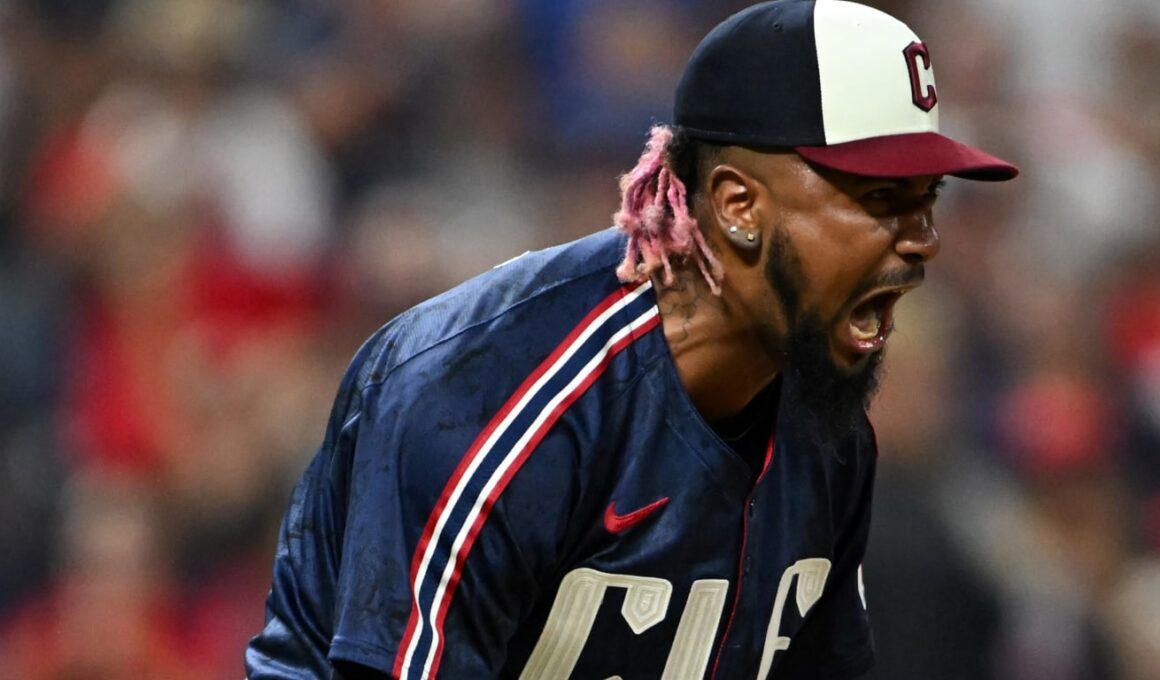The unsung pitchers — and one All-Star — leading MLB’s best bullpen
The Cleveland Guardians won 40 of their first 60 games this season behind an offense that was among baseball’s best. But their lineup has scuffled since the start of July, averaging just 3.7 runs per game.
The starting rotation was able to withstand numerous injuries for a while, but it has turned in a 4.76 ERA over that same period.
As those units have ebbed and flowed, there has been one constant: Cleveland’s outstanding — and possibly historic — bullpen. Even as the team was swept in Milwaukee over the weekend, the relief corps did its job, tossing nine scoreless innings.
It was a continuation of what Guardians relievers have done all season long. And it has led to some eye-catching numbers thus far:
- Cleveland’s 2.76 bullpen ERA would be the franchise’s single-season best since 1976 (2.61). The most recent team to have a lower bullpen ERA was the 2014 Mariners (2.59).
- Over the past 20 full seasons, only the 2012 Rays ‘pen had a better opponents’ OPS (.597) than what the Guardians have accomplished to this point (.601).
- Cleveland’s .201 opponents’ batting average would be the third-lowest by a bullpen since 1920, behind only the 1968 Tigers (.198) and the ’65 White Sox (.200).
- Finally, this Cleveland crew has posted an 11.44 win probability added. They could have the highest WPA in Major League history by the end of the regular season.
So, who is responsible for this? There is a vaunted three-time All-Star in the mix, but other key contributors are relatively unheralded. They include two rookies, a 27-year-old lefty in his second big league year, and an overlooked in-season acquisition.
As they continue to rack up zeroes and shut down opposing hitters, you should know their names.
All stats updated through Sunday.
The stud: Emmanuel Clase
Most baseball fans know about Clase – and most hitters fear him in the ninth.
He has been baseball’s best relief pitcher since taking over as Cleveland’s closer in 2021. His diabolical cutter has the most run value of any pitch thrown by a reliever in those three-plus years, and Cubs manager Craig Counsell recently mentioned Clase’s cutter in the same sentence as Mariano Rivera’s. But Clase, unlike the Hall of Famer, attacks hitters at almost 100 mph.
However, he wasn’t his typically dominant self last season, even as he led MLB with 44 saves. After logging a 1.33 ERA across 142 1/3 innings from 2021-22, Clase’s ERA rose to 3.22. He wasn’t getting as many ground balls, batters were making better contact against him, and the slugging percentage on his cutter increased 129 points from 2022 (.245 to .374).
This season has been a return to form and then some for Clase as his cutter, which he is throwing 81.2% of the time, has registered a .160 opponents’ batting average and a .213 slugging percentage, which is the third-lowest in MLB on any single pitch type (min. 150 plate appearances ending on that pitch).
What has made the difference? Improved pitch location helps. Last season, Clase filled the middle of the strike zone with his cutter and was unable to get it on the edges consistently. This year, his cutter is hitting those edges to both righty and lefty batters. The pitch’s vertical drop has also been reduced by nearly two inches thereby allowing it to stay above the heart of the plate more frequently.
The results have been astounding. Clase’s hard-hit and ground-ball rates are back near the top of the scale, but what really stands out is his 0.63 ERA. That would be the fourth-lowest single-season mark among pitchers with at least 50 innings since 1913, when ERA became official in both leagues. The three in front of Clase: Dennis Eckersley (0.61 ERA for the 1990 A’s), Fernando Rodney (0.60 ERA for the 2012 Rays), and Zack Britton (0.54 ERA for the 2016 Orioles).
The rookies: Cade Smith and Hunter Gaddis
Say hello to the two hurlers leading all rookies in appearances.
Smith, a native Canadian who attended the University of Hawaii, wasn’t picked during the abbreviated five-round 2020 MLB Draft and signed with the Guardians as a free agent. He put up big strikeout numbers in the Minors (262 K’s in 167 innings) but had a 4.65 ERA in 30 appearances at Triple-A last year and was far from a lock to make Cleveland’s roster this spring.
He ultimately earned a spot and has been sending flummoxed batters back to the dugout since day one. Smith set a club record in his MLB debut as he tallied five strikeouts in two innings. Three of those punchouts came on his four-seamer, which has the highest run value of any pitch in the Majors. Yes, even more than Clase’s cutter.
Smith’s heater averages “just” 96 mph, but he locates it near the top of the zone, and it gets on hitters quickly thanks to the right-hander’s 7.4 feet of extension, which ranks in the 98th percentile. That has contributed to Smith’s 1.98 ERA and his 35.7% strikeout rate, trailing only Josh Hader’s 39.1% among pitchers who have faced at least 200 batters.
Although Smith will change hitters’ eye levels with a diving splitter that he uses about 20% of the time, his fastball has accounted for 63 of his 81 strikeouts. That’s the second-most K’s on a single pitch type this year.
Gaddis, a fifth-round Draft pick in 2019, doesn’t have the swing-and-miss stuff that Clase and Smith harness. But he has been better than his bullpen mates in some aspects, including opponents’ batting average (.157) and expected ERA, where each member of the trio ranks inside the top five.
Lowest expected ERA, 2024
Min. 200 batters faced (261 pitchers)
1. Bryan Woo (SEA): 2.23
2. Hunter Gaddis (CLE): 2.28
3. Griffin Jax (MIN): 2.30
4-T. Cade Smith (CLE): 2.56
4-T. Emmanuel Clase (CLE): 2.56
Gaddis’ actual ERA is 1.40, more than three runs lower than last year when he was used more as a starter. He allowed 21 earned runs in 42 innings and struck out just 24 batters. This year, he has nearly doubled his K rate (from 13.2% to 25.9%). The simplest answer as to how is that Gaddis is just a completely different pitcher.
He is throwing with greater velocity, spin and extension. After leading with his fastball in ‘23, Gaddis’ top pitch this season is a high-80s slider. Meanwhile, his changeup has gained much more movement from last year, and opposing hitters are 2-for-31 with 14 strikeouts against it.
The unheralded southpaw: Tim Herrin
Manager Stephen Vogt will often turn to Smith, Gaddis and Clase to nail down the final nine outs in a victory. Not a bad plan considering they all rank among the top five relievers in run value. But this bullpen quality arms beyond that big three.
Herrin, a 29th-round Draft pick in 2018, was fairly effective last year against left-handed batters, limiting them to a .667 OPS. But he didn’t have a weapon to stymie righties, who slashed .308/.378/.446 against him and clobbered his four-seamer (.516 slugging percentage).
He has found a weapon with his curveball, which he has emphasized this season and uses mostly against righties. That offering has registered a 39.2% K rate and a 25.9% hard-hit rate against opposite-handed batters. Meanwhile, Herrin’s slugging percentage allowed to righties on his fastball has plummeted to a scant .206.
Oh, and lefty batters have almost no shot against Herrin now. They are 7-for-71 with two extra-base hits and 24 strikeouts.
The early-season addition: Pedro Avila
Avila wasn’t a part of Cleveland’s plans until mid-April. After a decent 2023 season in which he made 14 appearances (six starts) for the Padres, the 27-year-old Avila permitted eight earned runs over his first four appearances of the season, spread over eight innings. He was dealt to Cleveland for cash on April 17 and made his Guardians debut one week later.
It hasn’t been a totally smooth journey for Avila with his new team; he had his fair share of forgettable outings early on. But since June 1, he has registered a 2.39 ERA across 37 2/3 frames. His barrel rate during that span is a stellar 3.1%, and batters have slashed a measly .205/.308/.311 against him. Avila’s expected slash line is pretty close to what he has produced, too.
Walks are a problem for Avila (11% BB rate), but he’s also averaging more than a strikeout per inning. His fastball and changeup — his two most frequently used pitches — have combined for a .191 opponents’ batting average over the past two-plus months, and no one has gotten a hit off of Avila’s curveball since May 7 (0-for-24, 14 strikeouts).
Most of Avila’s appearances still come in low-leverage situations, but as he has given up only two runs in 16 innings since the All-Star break, he is proving to be yet another dependable arm out of this ‘pen.
And finally …
Scott Barlow owns a 30.1% strikeout rate and has generated a lot of soft contact in his first season with Cleveland. Nick Sandlin, a 2018 second-round pick, is having another above-average campaign, highlighted by a 34.8% whiff rate. Eli Morgan, a converted starter whose season has been interrupted by injuries, owns a 1.77 ERA across 17 appearances.
It’s also worth noting that the Guardians are doing this without Trevor Stephan, James Karinchak and Sam Hentges, all of whom have been key bullpen cogs at points over the past few seasons and are currently on the injured list. Stephan won’t pitch again this year. The same might be true for Karinchak and Hentges. With or without them, these Guardians have their sights set on an AL Central crown and another postseason run.
Having a deep and dangerous bullpen has long been one of the most vital commodities for a World Series contender. The Guardians, if they reach October, will look to ride their distinct advantage to the club’s first championship since 1947.









